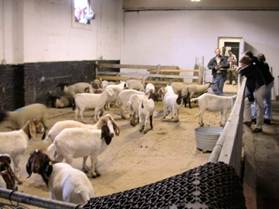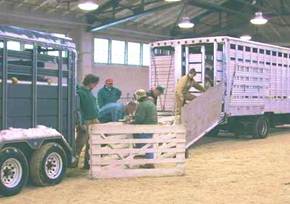Education
Adventures in Market Pooling to Live Animal Markets
Chris Parsons
(2002/2003 Interim Marketing Coordinator, Northeast Sheep and Goat Marketing Program at Cornell University)
Pulling together a producer pool to market lamb and goats from Central New York to a NYC live market sounds like an easy process. Certainly, the concept is easy to understand. All you need to do is locate a strong market that uses lots of goats and lambs, set up a contract with the buyer from that market, and gather up and ship off all the livestock from your area that will fill their needs. Following Bob Melchior's death in the summer of 2002, I was hired to replace him as a marketing coordinator for the Northeast Sheep and Goat Marketing Program at Cornell University. Almost immediately, I found myself assigned this task.
A group of goat and lamb producers in a 2 hr radius of Trumansburg, NY had requested assistance from the Northeast Sheep and Goat Marketing Program staff to market directly to live animal markets in NYC. Live animal markets are very unique. There are about 21 live animal markets in NYC that market lambs and goats. A consumer can go into them and view the goats and lambs on display. The customer visually selects an animal to purchase. After taking formal ownership of the animal, the animal is legally slaughtered in the custom slaughterhouse on the same grounds. The customer waits for the animal to be processed or comes back later for the meat.
 In previous trips to NYC, Cornell staff, Cooperative Extension Educators and farmers had had the opportunity to view some of these markets. Producers had been able to explain to the live market owners the type of animals they would be able to provide. Additionally, by viewing first hand, the type of animals sold through these markets, producers and NESGMP staff felt they would be better able to grade the sheep and goats they themselves were selling to the markets.
In previous trips to NYC, Cornell staff, Cooperative Extension Educators and farmers had had the opportunity to view some of these markets. Producers had been able to explain to the live market owners the type of animals they would be able to provide. Additionally, by viewing first hand, the type of animals sold through these markets, producers and NESGMP staff felt they would be better able to grade the sheep and goats they themselves were selling to the markets.
Bob Melchior suggested two live animal markets to this producer group as being potential markets for local animals. Operators of both markets were interested in purchasing direct from farmers and both rated the quality of their animals as highly important to their customers. Negotiations took place with these two markets and at this point I entered into the equation. One of these markets was RD's Live Poultry, in Queens, NY. A part owner, Permanand Raghoo, in charge of animal purchases for their market, was very excited about working with local producers and appeared willing to go an extra mile to make it work. His price was slightly better and, unlike the other market, he had the ability to do his own trucking. Finding a trucker to go into NYC, we found out later, is a difficult task.
The producers and Mr. Raghoo settled on $1.15 per pound for goat kids with Boer influence, to include wethers, bucks and doelings. The preferred weight range was from 60 to 120 pounds. Lambs would be bought at $1.10 per pound with the same weight range as the goats. For his market, Mr. Raghoo preferred the animals to be in finished condition, but on the leaner side. A 4% shrink discount was later offered to Mr. Raghoo for each animal purchased.
Other animals to be purchased included culled does at 85 cents per pound. Breed had no bearing on this category, but the does needed to be in healthy condition, and, ideally not too fat or lean. Older, larger bucks and ewes were purchased at a negotiated price on an individual basis.
The first shipment of animals was scheduled to be purchased on November 21st for the Muslim Ramadan season. Two weeks earlier, Mr. Raghoo accompanied me on a tour of several of the farms in this pooling group. These visits gave Mr. Raghoo an idea of the types and quality of animals he could anticipate purchasing.
To coordinate the first shipment of animals, it was predetermined that a second purchase would take place in the second week of December to help supply the store for Christmas sales. Mr. Raghoo's typical Christmas holiday needs included 300 lambs and 500 goats. As we began to fill that first truck, it was decided that our marketing pool would try to fill as much of his holiday needs as possible. Mr. Raghoo was very excited at this prospect, and agreed to purchase four truckloads of animals which would require gathering 85 to 90 head per load.
One of the first requirements was to fill the truck with the type of animals requested by Mr. Raghoo. Each producer's needs for marketing their livestock also had to be determined. This included juggling some time schedules so that on particular shipping days, the correct type of animals would be delivered without compromising the capacity for each truckload.
The first truckload of animals was put together at Capricorn Hill Farm in Pine City, NY. Individual producers trucked their livestock to this pick-up point. But several producers indicated that once there was a lot of snow on the ground they would be unable to traverse the driveway at Capricorn Hill farm. Each animal was weighed individually on a digital scale owned by Capricorn Hill farm and then moved to Mr. Raghoo's truck. Payment for the livestock was done after the truck was loaded. For the first load, Mr. Raghoo agreed to make payment in cash. Later future payments were all paid by check without a problem.
 Later shipments were completed on December 12, 16 and 20th, with the exchange of animals at the Cornell University's livestock pavilion. Some of these truckloads were made up from the original producers in the pool but in order to meet demand we were also able to locate other local producers from the Cornell Small Ruminant marketing list server, srmarketing-l@cornell.edu, and from the Holiday Listing forms that producers turned in to Cornell indicating that they had lambs and goats for sale. When possible, I viewed the animals at each farm prior to shipment to ensure that they met Mr. Rahgoo's criteria.
Later shipments were completed on December 12, 16 and 20th, with the exchange of animals at the Cornell University's livestock pavilion. Some of these truckloads were made up from the original producers in the pool but in order to meet demand we were also able to locate other local producers from the Cornell Small Ruminant marketing list server, srmarketing-l@cornell.edu, and from the Holiday Listing forms that producers turned in to Cornell indicating that they had lambs and goats for sale. When possible, I viewed the animals at each farm prior to shipment to ensure that they met Mr. Rahgoo's criteria.
A fifth truck was scheduled for pick up on December 27th, with a total of 70 lambs and goats. Mr. Raghoo had to cancel this purchase of animals. We had not been able to meet all his initial needs so at some point he had had to purchase animals from the New Holland auction and the New Holland animals had lower than expected holiday sales. As a backup, I had pre-arranged with Mr. Roggen, a buyer near Batavia, NY, to purchase some of these animals under such circumstances. Mr. Roggen was able to purchase 20 goats on the morning of the 27th.
In total, approximately 350 lambs and goats were marketed through this pool. Everyone involved seemed very pleased with the entire system. Future sales are planned with both Mr. Raghoo and Mr. Roggen.
Several things were learned through this extraordinary pilot project. The person designated to coordinate the purchases needs to be prepared to spend a fair amount of time initially checking the quality of the animals to be sold, arranging for the sale location, and ensuring that all the producers show up as planned. For example, one producer had agreed to sell animals through the pool but decided several days prior to the sale to sell his animals elsewhere without immediately notifying me of his change of plans. A verbal commitment to sell needs to be kept as surely as the buyer is committed to show up to buy.
In order to make the pooling system work, producers need to be more certain of the numbers of animals they have for sale as well as their actual weights. There were numerous times, after being given ample time, that producers still had only foggy estimates of their animal weights. This lack of awareness does not instill buyers with a great deal of confidence in producers, especially when dealing direct.
Being on time for the sale is important for both the buyer and seller. There was only one time that the tardiness of one of the producers delayed the loading process of the sale. This was an inconvenience to a buyer that was very committed to showing up on time and who was trying to avoid rush hour in NYC.
The subject of pricing caused some controversy. During the sale of the second truckload, a drop in pricing on the cull does was offered by the buyer, after the animals were loaded onto the buyers truck. The situation was corrected, and no pricing problems arose after that incident.
In general, the producers who grouped together to form this pool overcame several obstacles and now feel they are on their way to a long-term relationship with these two buyers. The experience also indicated the importance of being able to supply quantities of similar animals from each centralized pick-up point. Our hope with the Northeast Sheep and Goat Marketing Program is that this type of pooling will be set up throughout the Northeast US and encompass many farms.
Please note – this market pool did not continue over the years although individual farmers and farmers turned middlemen continued to sell to NYC live animal markets. Problems the pool encountered were: 1) unable to provide sufficient quantity of consistent product year round, 2) hard to predict what shrinkage loss would be, very variable from one type of animal to another (fat does versus weaned kids), 3) buyer could not find a reliable person to truck animals. Thus, had to justify his time away from his actual business, and 4) difficult for farmer acting as "marketing coordinator" to enforce quality standards –assumption that buyer would speak out if there was a problem.
